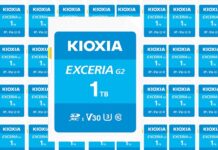Hitachi Vantara has plumped up the VSP E series arrays with two midrange additions at “aggressive price points”, plus a NAS gateway and a managed service.
Update: E790 and E590 differences added. 10 December 2020.
The company launched the high-end E990 NVMe all-flash array in April. The new E790 and E590 join the E Series range, along with the HNAS 5000 file storage gateway. Hitachi Vantara has opened up Hitachi Virtual Storage as a Service (VSaaS) to cater for customers that don’t want the hassle of managing the hardware.

The E790 and E590 have less than 66uS data access latency. Hitachi Vantara is not supplying speeds and feeds data apart from this and saying the two have active:active controllers inside their 2RU base chassis.
The E790 controller CPU is a 4 x 16 core 2.1 GHz Xeon, delivering 4 million IOPS and 22GB/sec, while the E590 uses a 4 x 6 core 1.9 GHz Xeon outputting 6.8 million IOPS and 32GB/sec. The two systems have the same maximum internal raw capacity of 361TB but the E590’s max external capacity is 144PB compared to the E790’s 216PB. Neither system can have expansion trays. The E590 is priced below the E790.
The shared base chassis can hold 24 SSDs, whose capacities can be 1.9TB, 3.8TB, 7.6TB, or 15.3 TB. RAID levels 5, 6 and 1 are available; specifically RAID6 (6D+2P, 12D+2P, 14D+2P), RAID5 (3D+1P, 4D+1P, 6D+1P, 7D+1P), and RAID1 (2D+2D, 4D+4D). External access can be via 24 x 16 or 32Gbit/s Fibre Channel ports or 12 x 10Gbit/s iSCSI.
Hitachi said the array increases effective capacity, courtesy of data reduction software and provides a 4:1 effective capacity guarantee. The E Series incorporates embedded management software to speed installation and provisioning storage to applications. They can also be managed by Ops Center, Hitachi’s enterprise-grade management software.
There are three series of products in Hitachi Vantara’s VSP (Virtual Storage Platform) all running Hitachi’s SVOS RF software:
- E Series all-flash NVMe and SAS drive arrays with up to 21m IOPS, and down to 70μs latency
- F Series all-flash SAS array with 600K to 4.8 million IOPS
- G Series of hybrid flash/disk array with up to 4.8 million IOPS.
Managed VSP service
According to the company, VSP STaaS provides predictable rates for easy budgeting and a fast self-service console for users to adapt the array to changing needs. Hitachi STaaS is available through resellers, and managed VSP arrays can be located on-premises or in a co-location centre.

It has a pay-as-you-go scheme with a four-hour service activation period when a user requests more capacity. The array is delivered in an over-provisioned state to allow for growth.
E Series competition
Lacking speeds and feeds data from Hitachi, we are unable to position the new arrays precisely. But we think the E Series arrays will line up against Dell’s PowerMax and PowerStore arrays, NetApp’s ONTAP all-flash arrays, HPE Primera and Nimble arrays, and IBM’s Flash Systems. These arrays typically support unified file and block workloads without having an additional file gateway system.
Hitachi’s gateway enables file performance to scale separately from block performance.
Pure Storage has introduced a managed storage service delivered via partners. There are four block and two unified file and object tiers in its service catalog. HPE offers a managed service in its GreenLake portfolio, and Zadara also has a managed array service .
Getting NASty with a file gateway
The HNAS 5000 family of clusterable NAS gateway systems front-end a VSP array and store files on it, with CIFS and NFS access supported. Using rules and policies, files can be offloaded to any type of remote target including public clouds.
The controllers are accelerated with FPGAs to deliver faster file services, and have twice the throughput of the previous HNAS system. That would be the HNAS 4000 series, announced in April 2016. It offered between two and eight nodes with maximum usable capacity ranging from 4PB to 16PB.

File system metadata is stored on the fastest-available storage. Metadata for small files, which is called an onode, is packed together. Up to eight onodes or files can be packed into one filesystem block, resulting in space saving, latency reduction and fewer writes to the storage.
The HNAS systems support file and block workloads, with deduplication, with an FPGA doing the hashing, and compression to increase effective storage capacity. They also support Kubernetes and Ansible.
HNAS offers linked, writable snapshot clones. With linked clones, thousands – even millions- of copies of data sets are created very rapidly while using near-zero extra capacity.
The file system namespace, with a cloud extension, supports up to 840 billion objects. The “cloud” means S3 targets, such as AWS, Azure and IBM COS, Hitachi’s HCP object system and IBM”s on-premises Cloud Object Storage. Files are moved to the cloud according to settable policies. Object replication with throughput throttling improves the system’s quality of service (QoS).
Hitachi says little to no administration, configuration or tuning is required and scheduling is not necessary. The system supports fully synchronous active-active clustering of up to 500km with automated takeover, when implemented with global-active device metro clustering. The latter feature ensures continuous operations with nonstop data access.
A cluster rolling upgrade process enables migration from HNAS 3000 and 4000 systems to the HNAS 5000.








